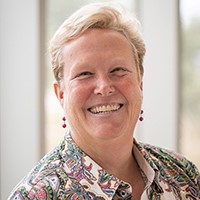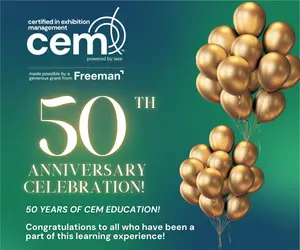By Mary Tucker, Sr. PR/Communications Manager, IAEE

In Part One of this blog series, Janet Sperstad, CMP-Fellow, Faculty Director, Event Management Business Solutions at Madison College discusses the often-overlooked trust factor as it relates to exhibitions and events, and why it is so important. Here, she breaks down the brain on trust and offers tips for show organizers on applying this information to make future events more successful.
IAEE: In Part One, you explain how effective trade shows are in maximizing the trust factor to create lasting business relationships. What can show organizers do to foster this environment of trust that you’re describing?
Janet: If you don’t do your job as a show organizer on getting the right people, you’re done. Whether that refers to the attendee side, the exhibitor side or the stakeholder side – people want to be around those who are confronting the same issues and challenges, as well as sharing the same successes. They want to figure out how to do their job better, faster, cheaper, more efficiently and more successfully.
Through marketing you can convey messaging such as, “You are in the right place” or “You can trust us” – these are powerful words for attendees! They think, “They’re going to have the right vendors. I need to be there; I don’t want to miss out.” The experiences we create are consumable and ephemeral, but you want the desired effects to continue beyond the show. Using influential language to let attendees know you’re a source for trust reconfirms what they value in their business circles.
With speakers, highlight their credentials. To build trust it is important to show attendees that you seriously thought about their experience at your show. Choose quality over quantity and emphasize that you’re listening. Tell your audience how important they are, show respect, and recognize status in a meaningful way. For example, recognize the exhibitors who have been with the show a long time in a way that really makes sense to attendees rather than using vague buzz words that don’t communicate the significance of their status.
How the actual show floor opens up to the attendee is another avenue for building trust. Giving people a chance to pick and choose in a curated format says a lot. Choices throughout the experience are very important; people want choices.
IAEE: Your class delves into the mechanisms of the brain as it relates to the trade show environment – you’ve dubbed it “the brain on trust.” Can you provide a brief overview for readers?
Janet: Absolutely! In a nutshell, here’s the brain on trust:
- The pre-frontal cortex functions better – you can think better, more quickly, engage in good decision making.
- The limbic system serves as the emotional center. When trust is present, it is in a state of comfort and it feels good because dopamine is going through it. In that state, you take in more information and you tend to share more information.
- The reward region of the brain (the dopamine region) lights up like a Christmas tree when you feel trusted and trust those around you. Show organizers want to nurture that throughout the show cycle – for example, say “Thank you for trusting us” when people register to set the tone early on.
- The other thing that’s important – we want people to learn, remember, go back to their job and do something differently because they came to our trade show experience. What happens in the hippocampus is that it gets activated even more than other senses when trust is present. Trust involves more of our brain than just the individual senses. The whole brain gets connected through neuropathways at trade shows in ways that some of the other experiences don’t. Ultimately it really activates our working memory – our hippocampus – more than so many other activities do.
IAEE: You also focus on the effect of oxytocin being released. How does that work?
Janet: One neurochemical that is so powerful for us is oxytocin. As oxytocin goes up, so does trust. And oxytocin really increases when we see each other, touch each other, give each other handshakes, high fives, fist bumps, elbow bumps, hugs, etc. The trade show is a beautiful environment in which oxytocin is happening everywhere and trust is being built all along.
IAEE: With all this sensory and neurochemical activity happening, how do you help attendees stay focused?
Janet: At the end of the day, attention is a choice made by the brain. That’s where one of the challenges of trade shows can lie because it can feel overwhelming. It’s also where having a design person who understands how to use the parameters of the show floor to its greatest advantage helps. For example, creating moods through lighting and placing smart resting spots throughout the show can enhance focus.
Applying those elements changes our neurochemicals, which changes our behavior, which influences whether we lean in or lean out, and influences relationships and trust. Oxytocin is incredibly overwhelming and it accelerates relationship and trust. We have to be careful to bring attention and focus in on where we want it, when we want it.
One example that comes to mind is that, as show organizers, we need to think about the entrance point which can be a real pain point. Going back to the concepts of threat and reward, that door can appear as a big threat. How can we counteract that? We can make sure we have a very welcoming carpet; have a sign that communicates, “Yes, you are in the right place;” and place a prominent map to give people a clear picture of where they might want to go. Give attendees that reassurance. And let’s not forget the exit – don’t let it just be a fadeaway, make sure you reiterate the value they bring by attending (and tap into that reward center).
IAEE: These are excellent tips! Do you have any parting words for show organizers?
Janet: There are a lot of ways to infuse trust in your show – language, visuals, etc. We don’t trust objects, we trust people. We engage with people. People do business with people and, ultimately, we do business with people we trust. Whether it’s through consistency, quality, timing – but also, you are bringing the right people together to help me do my job and learn new things to do it better. So, it’s an important component.
I also think we should keep the conversation going! Do readers agree with these findings? What has been your experience? I would love to hear from others on the subject.
Click here to learn more about the course Janet teaches, Neuroscience of Exhibitions and Events, along with the other modules in IAEE’s CEM Learning Program.


